Tarantulas are marvelous arachnids that come in a wide variety of shapes, sizes, and colors. Today, we’re going to take a look at the top 20 most colorful tarantula species.
Colorful tarantulas are highly desired by pet owners because they’re so beautiful to look at. As we’ll soon discover, some of these colorful tarantula species are absolutely stunning and are sure to make anyone who sees them stop and take a minute to admire them.
Now, without any further ado, let’s take a look at the top 20 most beautifully colored tarantula species!
20 Colorful Tarantulas
20. Davus Pentaloris
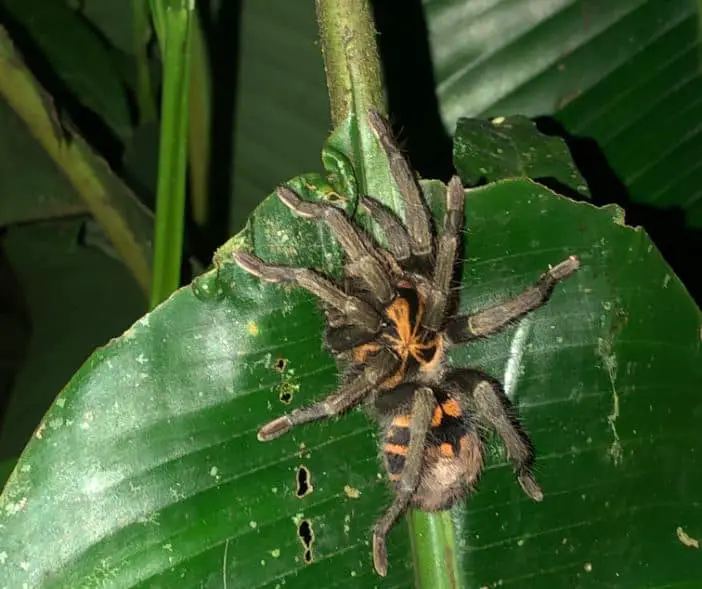
| Category | New World |
| Type | Terrestrial |
| Leg span | 4.75 inches |
| Growth speed | Fast |
| Lifespan | Females: 11 years / Males: 3 years |
| Experience level | Intermediate |
Davus Pentaloris, or the Guatemalan Tiger Rump, is a small dwarf tarantula that’s native to Guatemala. They’re known not only for their small size but also for their bright and unique color patterns that are red, copper, black, and blue.
In addition to their stunning appearance, this spider has a voracious feeding response but a docile nature towards humans, making them very suitable as pets.
They’re also quite heavy webbers and burrowers.
19. Monocentropus Balfouri
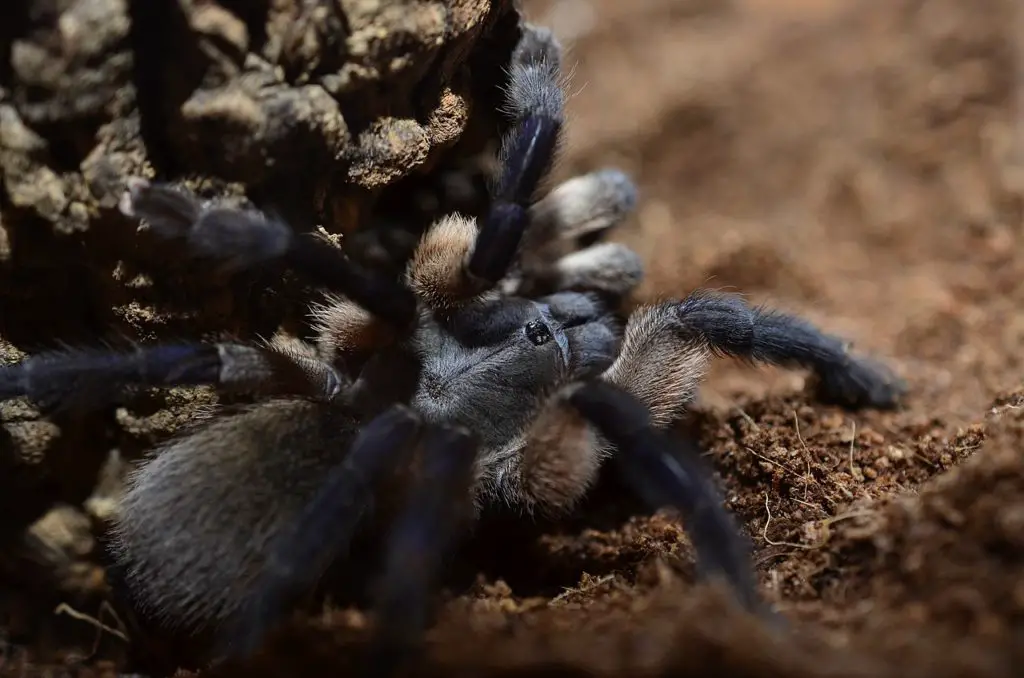
| Category | Old World |
| Type | Terrestrial |
| Leg span | 7 inches |
| Growth speed | Medium |
| Lifespan | Females: 12 to 14 years / Males: 3 to 4 years |
| Experience level | Intermediate |
The Monocentropus Balfouri is more commonly known by hobbyists as the Socotra Island Blue Baboon Tarantula. This is an Old World terrestrial species that is native to Socotra, an island off the coast of Yemen.
This beautiful spider is characterized by its beautiful blue coloration but it’s also very famous for the fact that it’s able to live communally.
18. Brachypelma Boehmei
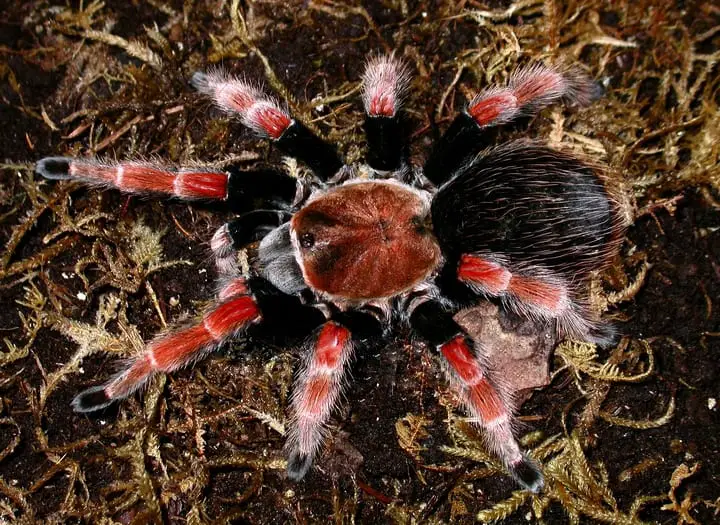
| Category | New World |
| Type | Terrestrial |
| Leg span | 6.5 inches |
| Growth speed | Slow |
| Lifespan | Females: 25 years / Males: 8 years |
| Experience level | Intermediate |
The Brachypelma Boehmei is known in the hobby as the Mexican Fireleg Tarantula. This is a New World terrestrial species that comes from Mexico and Belize.
They have an incredibly long lifespan, with females being able to live for up to 25 years!
They have bright orange colors over a black background which makes their beautiful coloration stand out even more.
The Mexican Fireleg is quite skittish and nervous, especially for a member of the Brachypelma genus, which is typically quite docile. They are not prone to biting, but they do have a tendency to release their urticating hairs.
17. Nhandu Chromatus
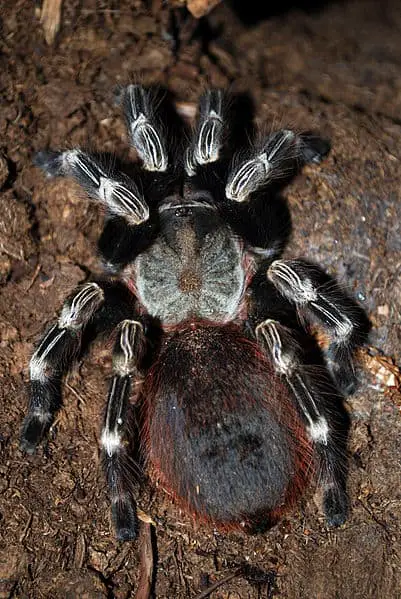
| Category | New World |
| Type | Terrestrial |
| Leg span | 7 inches |
| Growth speed | Medium |
| Lifespan | Females 15 years / Males 4 years |
| Experience level | Beginner – intermediate |
Nhandu Chromatus is known by hobbyists as the Brazilian Red and White Tarantula. It’s a large terrestrial species that, as the name suggests, is characterized by its stunning red and white coloration.
It’s a very popular species in the tarantula-keeping hobby not only because it’s a nice spider to look at but also because it’s quite a hardy and easy to care for species.
16. Pterinochilus Murinus
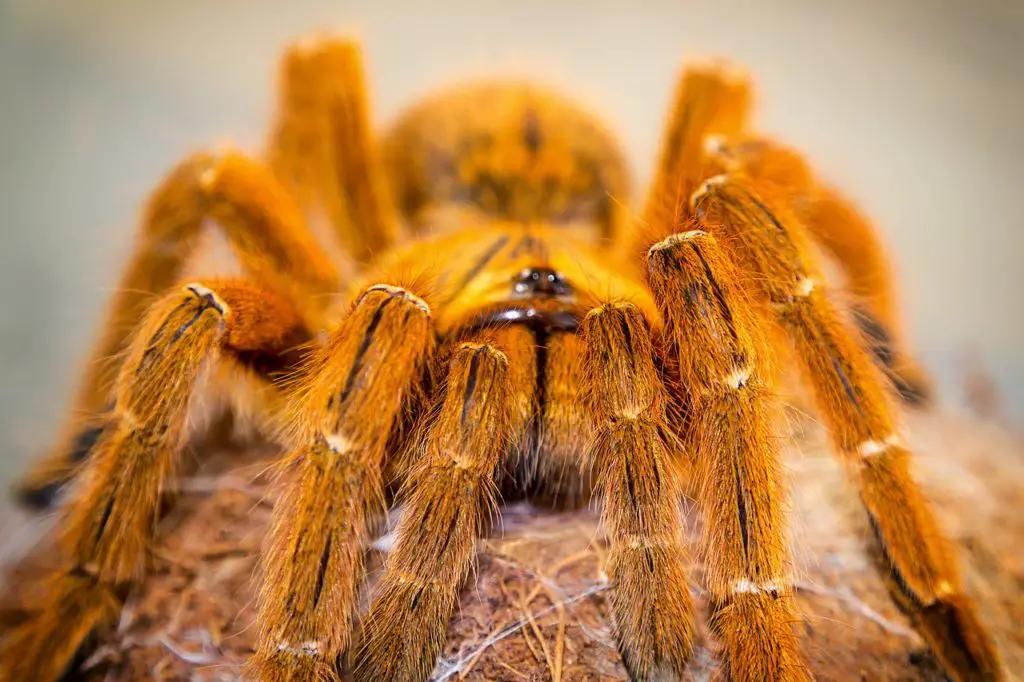
| Category | Old World |
| Type | Terrestrial |
| Leg span | Females: 4-6 inches. Males: 3-4 inches |
| Growth speed | Fast |
| Lifespan | Females: 14 years / Males: 4 years |
| Experience level | Advanced |
The Pterinochilus Murines is widely known as the Orange Baboon Tarantula. It’s an Old World terrestrial species that is native to a variety of countries in Africa. What’s interesting is that there are different color forms of this species in different countries.
The Orange Baboon Tarantula sports an intimidating orange color that’s very suitable for this intimidating spider.
Not for beginners, the Orange Baboon Tarantula is a defensive spider that’s not afraid to bite when it feels threatened. They have very potent venom and are incredibly quick!
15. Harpactira Pulchripes
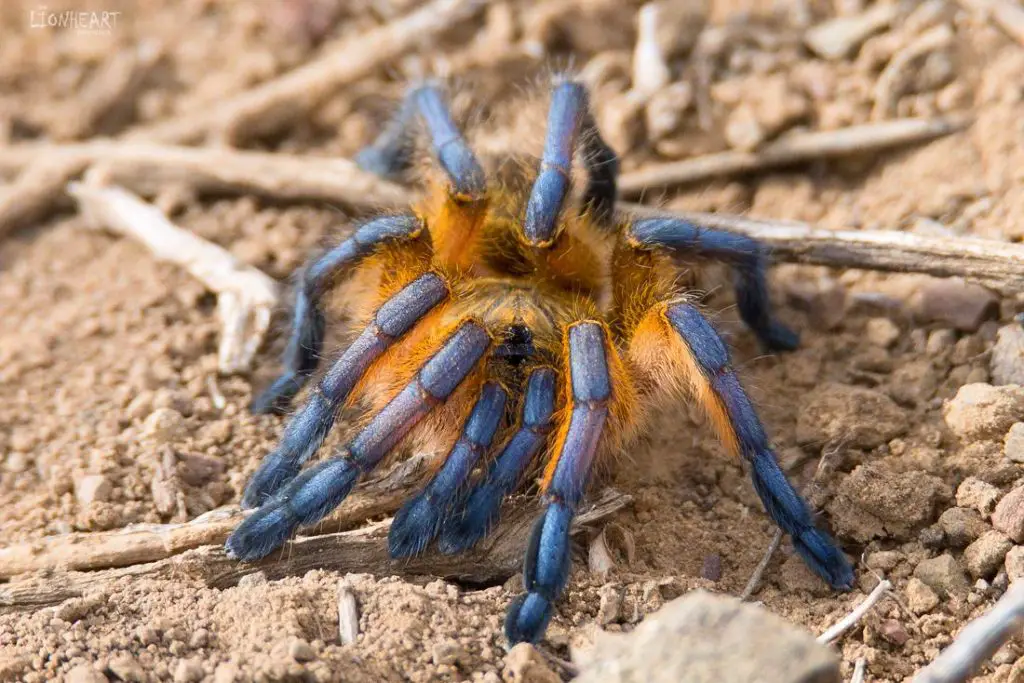
| Category | Old World |
| Type | Terrestrial |
| Leg span | 5 to 6 inches |
| Growth speed | Medium |
| Lifespan | Female: 10 to 12 years / Male: 2 to 3 years |
| Experience level | Intermediate |
The Golden Blue Leg Baboon Tarantula is scientifically known as the Harpactira Pulchripes. They’re a terrestrial species that comes from South Africa. Their common name is derived from their beautiful golden body and striking blue legs, making this a very colorful species.
However, their color is not for everyone. As is the case with most baboon spiders, the H. Pulchripes has potent venom. Luckily, they’re not as defensive as some other baboon tarantulas which makes them a bit easier to handle.
14. Pamphobeteus sp. Platyomma
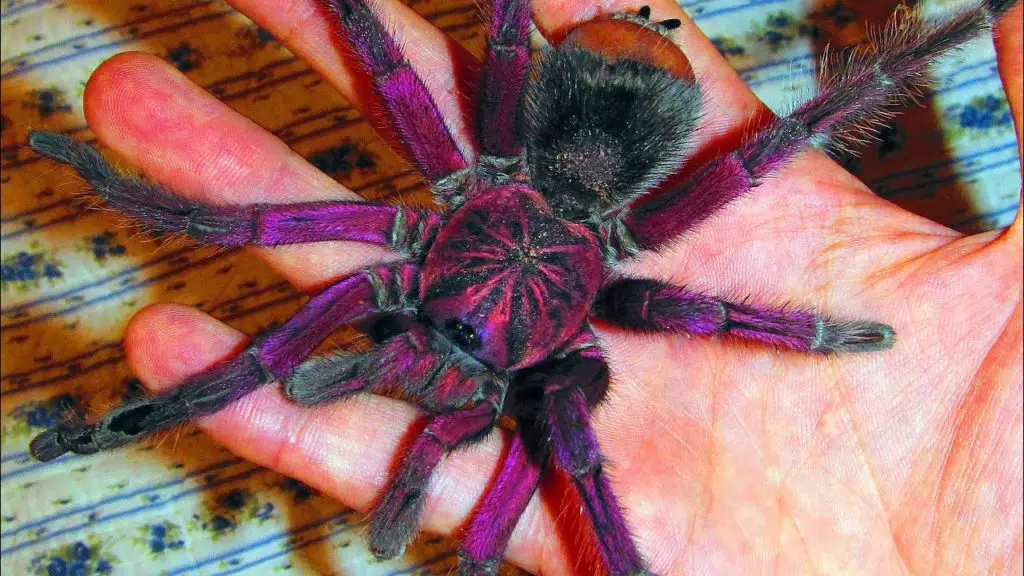
| Category | New World |
| Type | Terrestrial |
| Leg span | 8 inches |
| Growth speed | Medium – Fast |
| Lifespan | Females: 20 years / Males: 4-5 years |
| Experience level | Intermediate |
The Brazilian Pink Bloom Tarantula (Pamphobeteus sp. Platyomma) is not only one of the most colorful tarantulas but they’re also one of the biggest tarantula species!
As you might have guessed from their name, they’re famous for their stunning pink color.
They’re not too difficult to care for, but they do have a tendency to be a bit nervous and are quick to strike a threat pose.
13. Ybyrapora diversipes
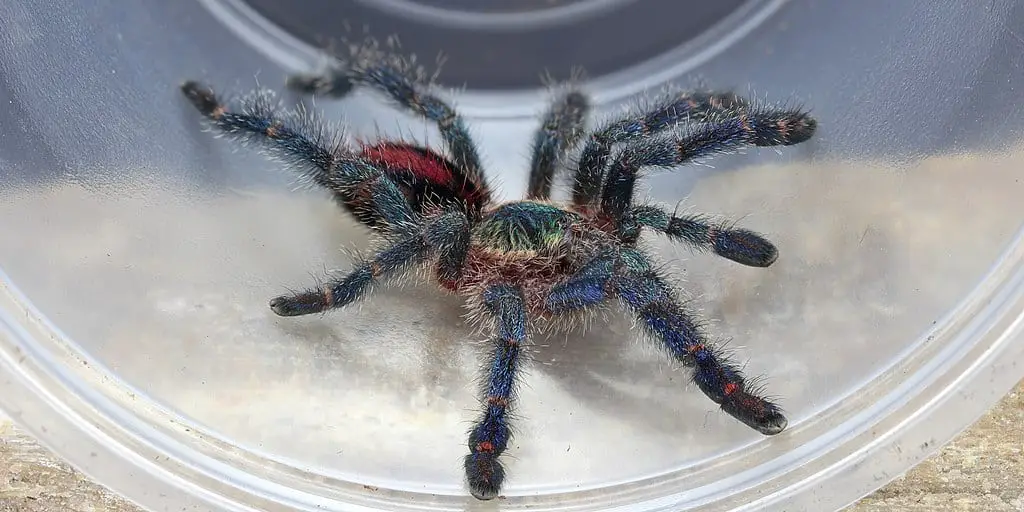
| Category | New World |
| Type | Arboreal |
| Leg span | 5.5 inches |
| Growth speed | Fast |
| Lifespan | Females: 12 to 14 years / Males 3 to 4 years |
| Experience level | Intermediate |
The Ybyrapore Diversipes, commonly known as the Amazon Sapphire Tarantula is an absolutely gorgeous spider that comes from the Amazon rainforest. They’re an Arboreal species that is an absolute pleasure to look at.
Slings and juveniles have green bodies covered with blue and reddish-pink setae. Their legs are electric blue with pink segments in their articulations. They have a green cephalothorax, often having pink stripes on both sides.
However, the biggest charm lies in the abdomen, where they have pale pink divided by blue horizontal lines at the side and a deep blue vertical line at the center topped by a bright reddish-pink stripe.
12. Omothymus violaceopes

| Category | Old World |
| Type | Arboreal |
| Leg span | 10 to 11 inches |
| Growth speed | Fast |
| Lifespan | Female: 14 years / Male: 5 years |
| Experience level | Advanced |
Scientifically known as the Omothymus Violaceopes, the Singapore Blue Tarantula has intense blue legs, with a brown or golden carapace and reddish setae. Their abdomen is also blue, but often less bright than the legs.
This species is not suitable for beginners due to the fact that they’re lightning-fast and quite defensive. Combine that with their potent venom and you have a spider that can be quite tricky to care for.
11. Birupes Simoroxigorum
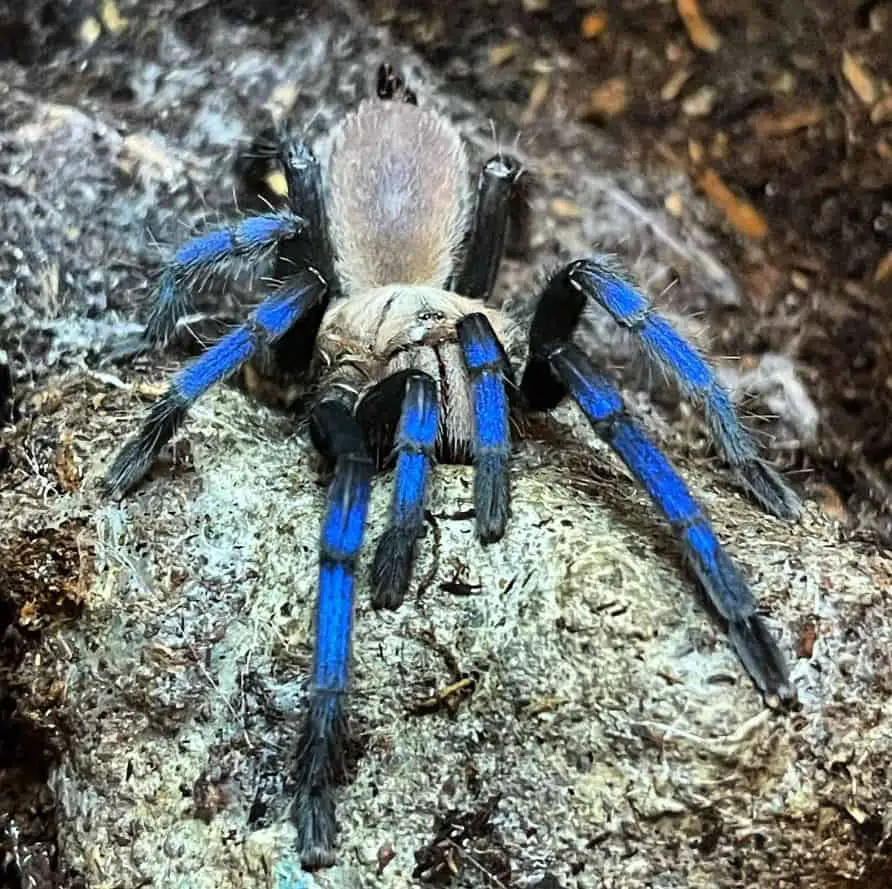
| Category | Old World |
| Type | Terrestrial |
| Leg span | 5 inches |
| Growth speed | Fast |
| Lifespan | Unknown |
| Experience level | Intermediate |
Birupes Simoroxigorum is a tarantula that’s better known as the Neon Blue Leg. They’re an Old World species that was discovered very recently in Borneo and that immediately drew a lot of attention due to their neon-blue legs.
Since this species is so new, a lot is still unknown about them, such as their lifespan. However, early reports indicate that they’re a relatively docile species.
10. Caribena Versicolor
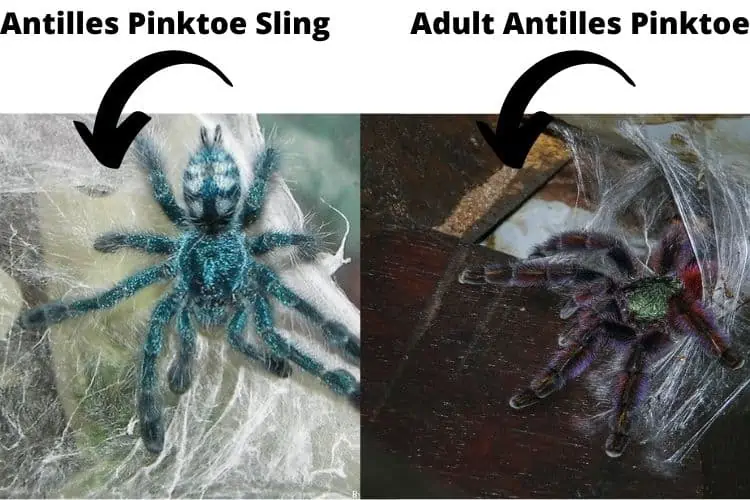
| Category | New World |
| Type | Arboreal |
| Leg span | 6 inches |
| Growth speed | Medium |
| Lifespan | Females 8 to 12 years / Males 2-3 years |
| Experience level | Beginner |
The Caribena Versicolor is known by hobbyists as the Antilles Pinktoe Tarantula. This is an absolutely gorgeous species that is native to the island of Martinique in the Antilles where they live in the trees.
As slings, these spiders are blue in color but as they grow, their color changes. When they’re fully grown, their carapace turns green, the abdomen red, and the legs become green with pink tarsi.
Males of this species are often more brightly colored than females.
9. Theraphosinae Sp. Panama
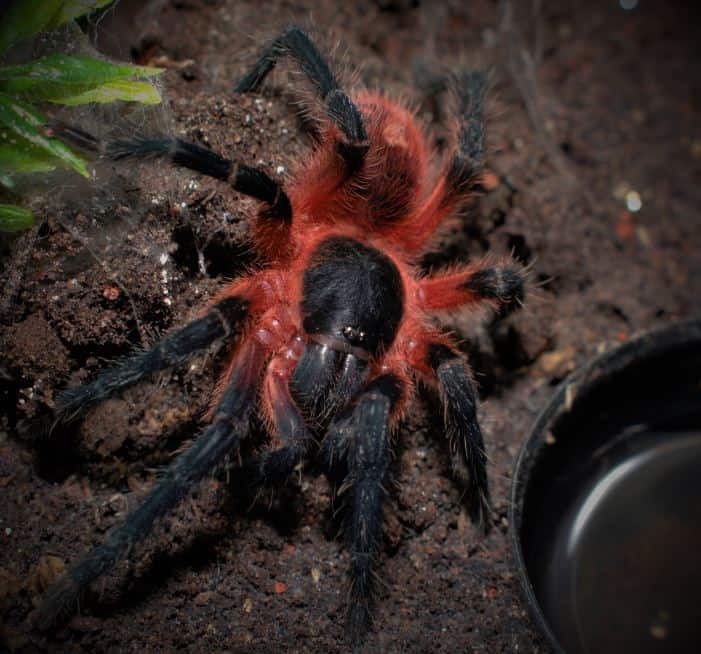
| Category | New World |
| Type | Terrestrial |
| Leg span | 4 inches |
| Growth speed | Medium – fast |
| Lifespan | Unknown |
| Experience level | Intermediate |
The Theraphosinae sp. Panama is aptly known as the Lava Spider. They got this name due to their dark carapace and legs that are partly orange colored, giving them a lava-like appearance.
They’re benign spiders that are relatively easy to care for. They’re also quite small, topping out at a size of around 4 inches.
8. Pterinopelma Sazimai
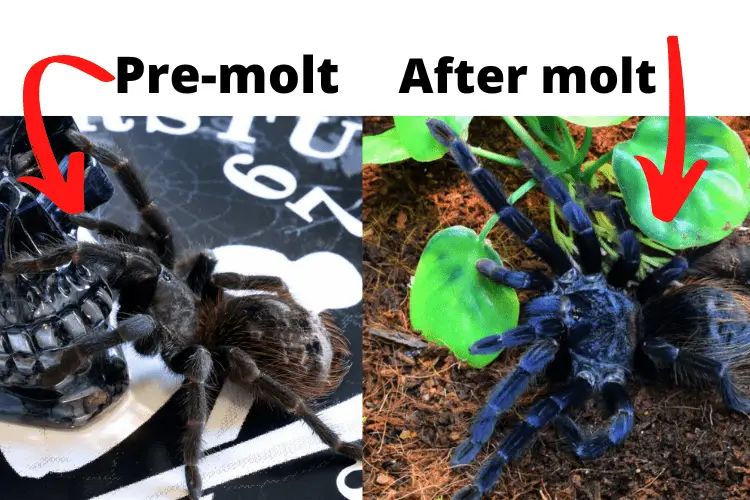
| Category | New World |
| Type | Terrestrial |
| Leg span | 5.5 to 6 inches |
| Growth speed | Medium to fast |
| Lifespan | 12 years |
| Experience level | Intermediate |
The Brazilian Blue Tarantula, scientifically known as the Pterinopelma Sazimai, is a beautiful spider found in Brazil. They were only recently discovered and can be quite skittish and nervous. Luckily, they’re much more likely to flee than to bite when they feel threatened.
This species is highly desired for its blue body accompanied by orange hairs over its abdomen. However, the blue tones aren’t always evident, and she sometimes looks like it has a dark gray color instead. The darker color is accentuated right before a molt, but the spider is blue again right after, especially under a direct light
Unfortunately, this is an endangered species, so if you want one as a pet, make sure that you buy one that was bred in captivity!
7. Ephebopus Cyanognathus
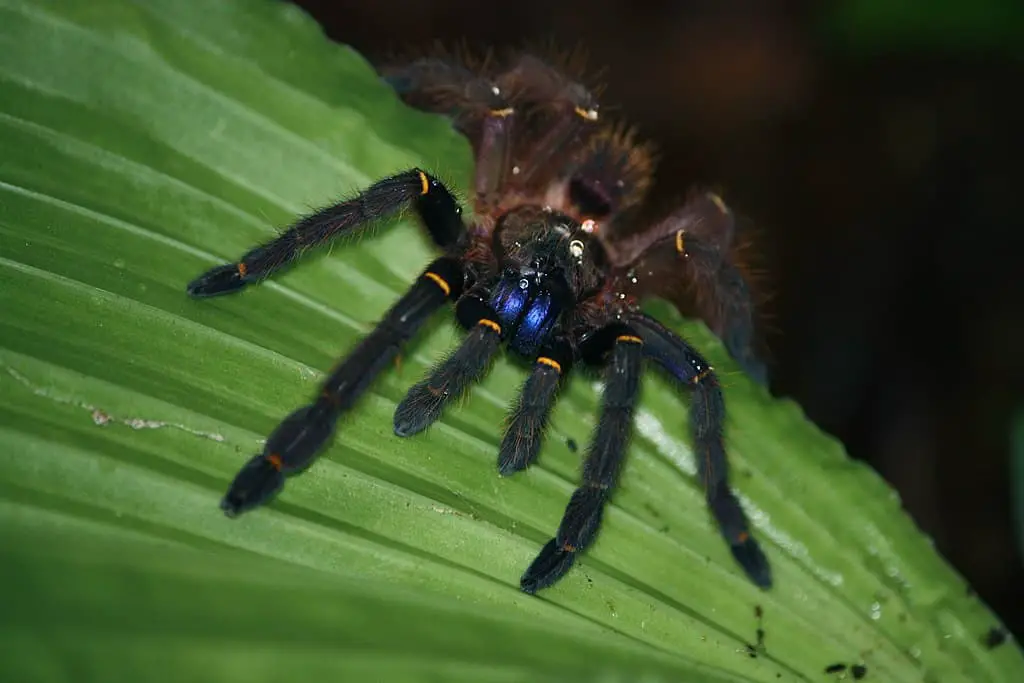
| Category | New World |
| Type | Terrestrial |
| Leg span | 4.5 to 5 inches |
| Growth speed | Fast |
| Lifespan | Females: 12 to 15 years / Males: 3 to 4 years. |
| Experience level | Intermediate – advanced |
Ephebopus cyanognathus, or the Blue Fang Tarantula is a relatively small species native to French Guyana. They’re known not only for their striking blue fangs, but also because they have a beautiful color palette that can consist of yellow, black, green, and orange. In addition, they have interesting orange rings on their legs. Especially the slings are incredibly beautiful in their appearance.
They’re relatively nervous and defensive, so they’re not very suitable for newbies.
6. Haploclastus Devamatha
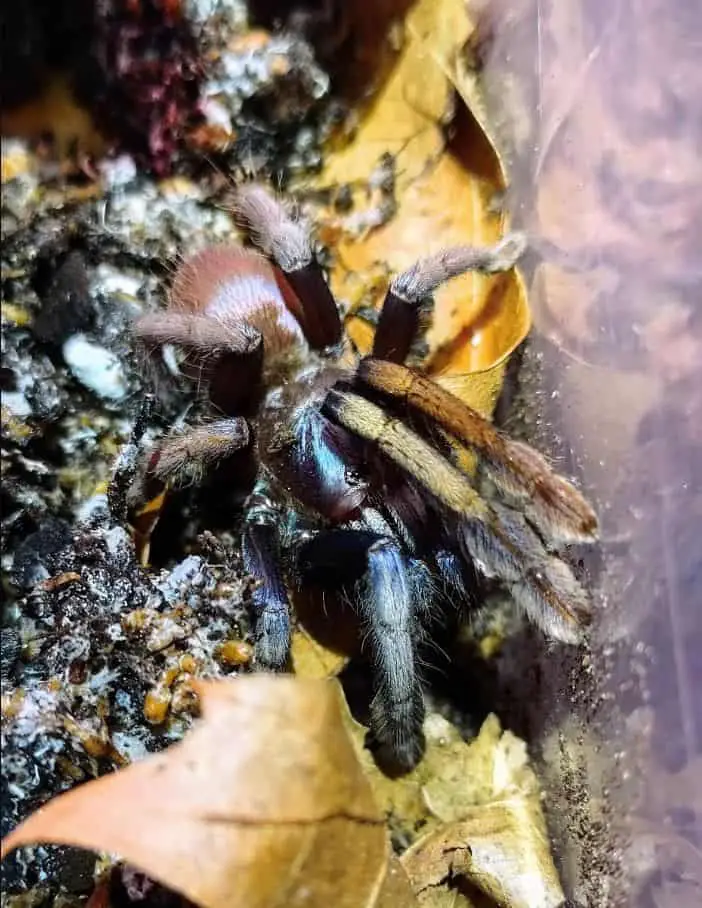
| Category | Old World |
| Type | Terrestrial |
| Leg span | 4.3 inches |
| Growth speed | Fast |
| Lifespan | Female: 12 to 15 years / Male: 2 to 4 years |
| Experience level | Intermediate – Advanced |
The Indian Rainbow Tarantula is the common name for the Haploclastus Devamatha. It’s a marvelous little spider that’s native to the Western Ghats region of India.
This spider excels in mesmerizing hobbyists with her beautiful set of colors. As a baby, she usually seems like your average brown-looking sling. However, as she matures, she develops a metallic and reflective sheen that goes around her femur and carapace.
The colors are primarily blue tones depending on the light’s angle, with a more metallic violet-looking abdomen. This spider comes in a pink and a blue version.
5. Poecilotheria Metallica
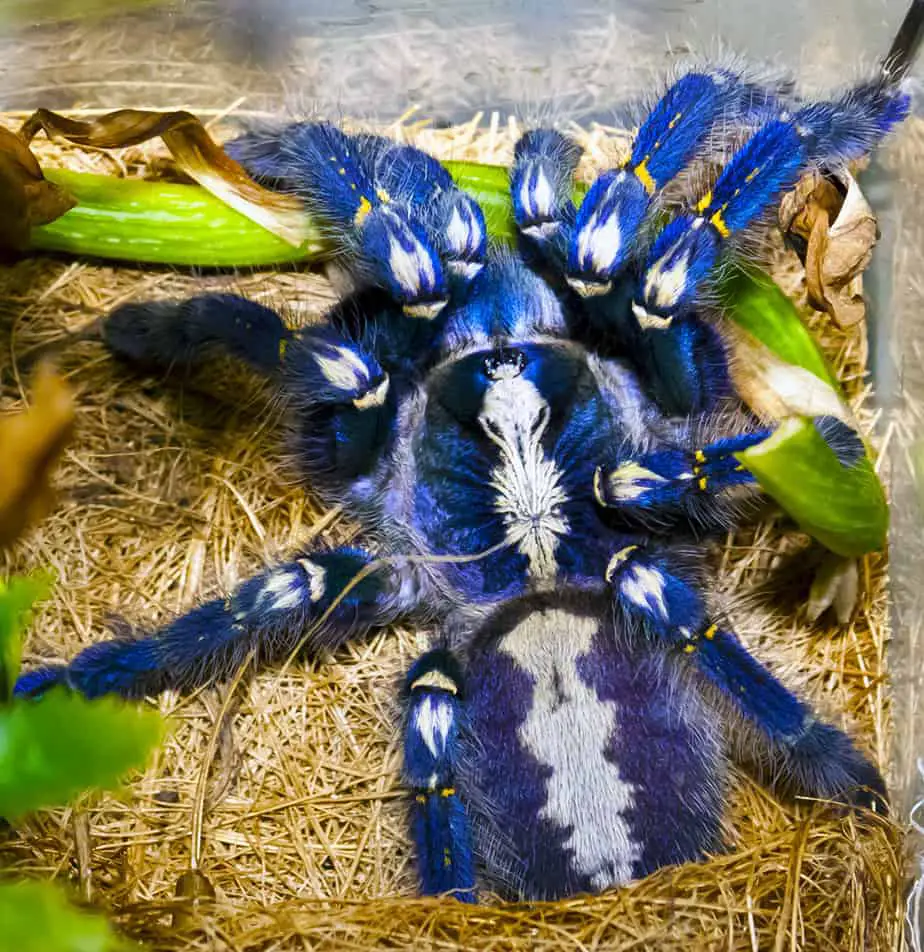
| Category | Old World |
| Type | Arboreal |
| Leg span | 6 to 8 inches |
| Growth speed | Fast |
| Lifespan | Female: 12 to 15 years / Male: 4 years |
| Experience level | Advanced |
The Poecilotheria Metallica, or Gooty Sapphire Tarantula, is probably one of the most famous Old World tarantula species, not in small part because of its striking sapphire coloration. They have a stunning blue color all over their legs, abdomen, carapace, and pedipalps. In addition, they have yellow and white spots on their legs and a striking white pattern that adorns their carapace and abdomen.
This spider is absolutely gorgeous to look at and is often considered the crown jewel of many collections. However, as a member of the Poecilotheria genus, they can be difficult to handle.
They can bite and are highly venomous and have large fangs, so caution is recommended. Luckily, they’re less defensive than some other pokies. Still, they’re not suitable for beginners.
4. Chromatopelma Cyaneopubescens
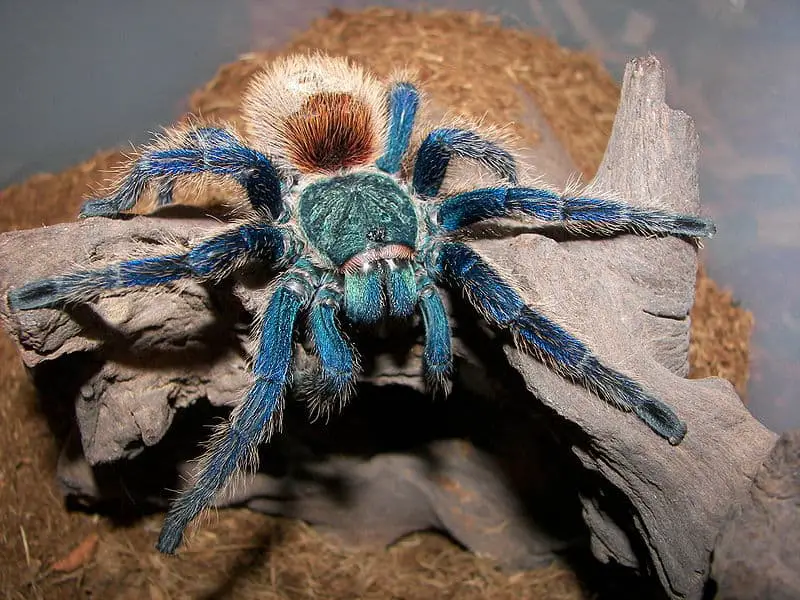
| Category | New World |
| Type | Terrestrial |
| Leg span | 6 inches |
| Growth speed | Medium |
| Lifespan | Females: 14 years / Males: 4 years |
| Experience level | Beginner |
The Chromatopelma Cyaneopubescens is known by hobbyists as the Greenbottle Blue Tarantula. This is without a doubt one of the most popular tarantula species and many keepers dream of one day owning one of these marvelous spiders. They have a blue-green carapace and metallic blue legs, making them a very unique spider.
In addition, they’re quite an active yet docile species, making them very suitable for beginners.
3. Dolichothele Diamantinensis
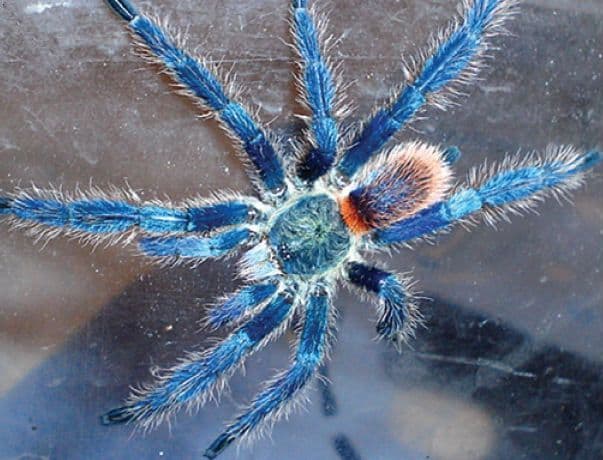
| Category | New World |
| Type | Terrestrial |
| Leg span | 3 inches |
| Growth speed | Fast |
| Lifespan | Females 12-15 years / Males 3 years |
| Experience level | Intermediate |
Dolichothele Diamantinensis is also known as the Brazilian blue dwarf beauty tarantula and was first described in 2009. Since they’re relatively new, not everything is known about them yet.
They’re a small species that is well known for its beautiful coloration. They’re often described as being a dwarf version of the Greenbottle blue, though they really have no relation to each other.
Though small, this species more than makes up for its small size with its beautiful colors. It has some of the brightest and most vibrant colorations of any tarantula and is an absolute marvel to behold. Males of this species are typically much brighter than females.
Another interesting feature of this spider is that even though it is a New World species, it does not have urticating hairs, making them much easier to handle.
2. Aphonopelma Mooreae

| Category | New World |
| Type | Terrestrial |
| Leg span | 5 inches |
| Growth speed | Medium |
| Lifespan | Females: 20 years / Males: 8 years |
| Experience level | Intermediate |
The Aphonopelma Mooreae, or Mexican Jade Fuego is an incredibly colorful spider. However, they’re very new to the hobby, so there are very few people who have an adult specimen. As spiderlings, they’re not as colorful, but as adults, few can rival their beauty.
They’re often described as a more “hairy” version of the GBB and have a metallic blueish color with red setae on their abdomen.
1. Typhochlaena Seladonia
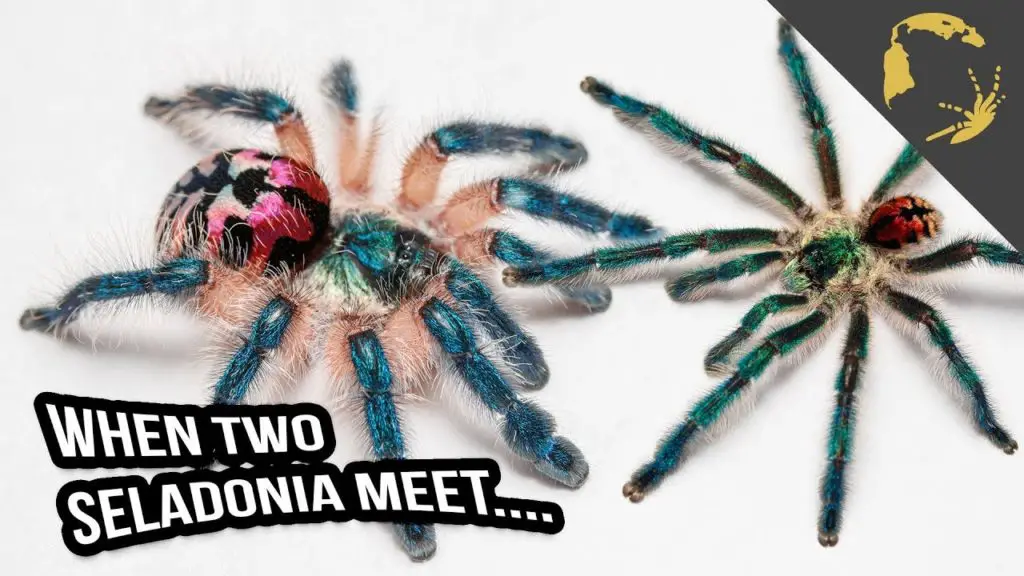
| Category | New World |
| Type | Arboreal |
| Leg span | Females 2.5″ / males 2″ |
| Growth speed | Medium |
| Lifespan | Females: 15 years / Males: 4 years |
| Experience level | Intermediate |
Typhochlaena Seladonia, beautifully named Brazilian Jewel Tarantula by hobbyists, is without a doubt the most colorful tarantula species on the planet (at least among the ones that have been discovered so far!).
Its carapace, legs, and abdomen all have a wide variety of different colors including blue, yellow, black, pink, red, and many others. They also have two rows of six spots on their dorsum, making them incredibly pretty.
They’re quite docile and calm and do not have a tendency to bite or strike a threat posture. If they do feel threatened, they prefer to run away rather than stand and fight. Even if they do bite, their venom is incredibly mild.
This spider hunts by creating a trapdoor web. As a result, you won’t often see their beautiful colors out in the open. Also, females and males of this species look very different, with females being much larger and thicker.
Final words
With over 800 documented tarantula species in the world, there’s truly something for everyone. Some people like small spiders, while others want massive ones. Whatever your preference, I think we can all agree that colorful tarantulas are some of the most beautiful and cool to look at. They’re simply a must-have for any collection.
I hope that this overview of the most colorful species has given you a good starting point on where to look if you’re after a species that will turn heads!
Some of the species on this list are quite rare, so be prepared for that. Also, some people are under the impression that brightly colored tarantulas are more venomous, but there’s no indication that that’s true. Some of the species listed here are not very venomous at all! The venom level of tarantulas has much more to do with whether they’re old or new world species than their appearance.
- How Long Do American Eskimo Dogs Live? Important Factors and Care Tips - September 29, 2023
- Do American Bulldogs Need Grooming? Essential Tips and Care Guidelines - September 29, 2023
- Do Bengal Cats Enjoy Playing? Essential Tips for Keeping Them Active - September 29, 2023